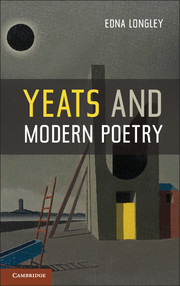Book contents
- Frontmatter
- Dedication
- Contents
- Preface
- Acknowledgements
- List of Abbreviations
- Chapter 1 Ireland as Audience: ‘To write for my own race’
- Chapter 2 Yeats and American Modernism
- Chapter 3 Intricate Trees: The Survival of Symbolism
- Chapter 4 ‘Monstrous familiar images’: Poetry and War, 1914–1923
- Chapter 5 Yeats’s Other Island
- Postscript
- Notes
- Index
Chapter 1 - Ireland as Audience: ‘To write for my own race’
Published online by Cambridge University Press: 05 June 2014
- Frontmatter
- Dedication
- Contents
- Preface
- Acknowledgements
- List of Abbreviations
- Chapter 1 Ireland as Audience: ‘To write for my own race’
- Chapter 2 Yeats and American Modernism
- Chapter 3 Intricate Trees: The Survival of Symbolism
- Chapter 4 ‘Monstrous familiar images’: Poetry and War, 1914–1923
- Chapter 5 Yeats’s Other Island
- Postscript
- Notes
- Index
Summary
Yeats’s presence in Irish poetry is not distinct from his presence in modern poetry. To ignore the former, which includes the sum of Irish critical responses to his work, may be to misunderstand the latter. The very failings of Irish criticism, failings bound up with its extra-literary contexts, gave it a unique influence on Yeats himself. To quote the reflexive crux of ‘The Fisherman’ (1914):
All day I’d looked in the face
What I had hoped ’twould be
To write for my own race
And the reality ...
Maybe a twelvemonth since
Suddenly I began,
In scorn of this audience,
Imagining a man ...
(CW1 148–9)
‘The Fisherman’, which has Synge in mind, consummates its own desire to write ‘one poem’ for an ideal Muse-reader. Insofar as a gap between actual and ideal audiences shaped Yeats’s poetry, what ‘my own race’ missed or misread was constitutive. But insofar as (during and after the poet’s lifetime) the same forces shaped Irish criticism, they weakened its ability and inclination to mediate ‘Yeats’. Some signals have been jammed. This chapter intertwines three histories: how Yeats’s Irish audience entered and changed his poetic structures; his hopes for an Irish criticism; Irish academic approaches (and reproaches) to Yeats.
- Type
- Chapter
- Information
- Yeats and Modern Poetry , pp. 1 - 33Publisher: Cambridge University PressPrint publication year: 2013



